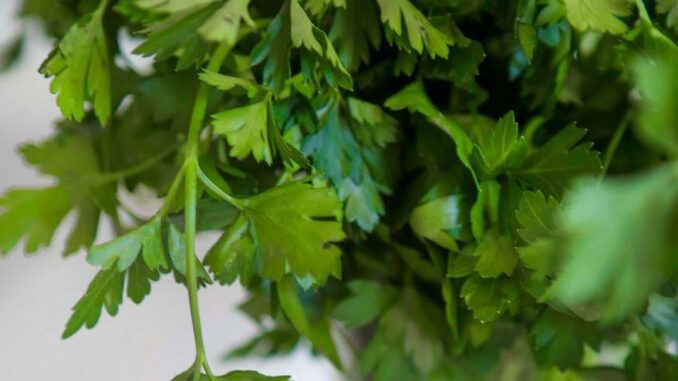
Garden columnist Dan Gill answers readers’ questions each week. To send a question, email Gill at gnogardening@agcenter.lsu.edu.
My parsley is beginning to send up flower stalks. Can I grow it through the summer, or is it finished? Mary
Although it is actually a biennial, we generally grow parsley as a cool-season annual. That means we typically plant it in the fall, it grows over the winter and spring, and it blooms and dies in late spring or early summer.
Fall-planted parsley plants are still growing and look fine, but we are certainly getting toward the end of the season, and many are blooming. As we reach early to mid-June, heat and insect pests begin to take their toll and the quality of the parsley goes down dramatically.
Flowering (bolting) signals the end of production. It would be best to harvest all remaining green leaves on your parsley plant over the next couple of weeks and freeze or dry them.
Leave the blooming parsley in the garden to bloom, however. The tiny flowers provide nectar for and attract parasitic wasps into the garden. These tiny, gnat-sized wasps (which pose no threat to us) attack and kill many insects in our gardens and help keep pests under control.
For those who planted parsley this spring, it will not likely bloom now and will continue to produce until the weather gets hot. Harvest generously and continue to harvest until growth slows due to high temperatures.
Left in the garden, spring-planted parsley often succumbs to the heat and dies during the summer (even if plants hang on, they do not like the heat and production is greatly reduced).
Plants that survive the summer will revive with the cooler temperatures of fall, produce abundantly over the fall, winter and spring, then bloom and die. In that situation, the parsley is growing like the biennial it is — growing one year and then blooming and dying the next. This advice also applies to cilantro as well.
I have a lawn that has been neglected for several years. Now we have a bad sticker problem. I understand that it is a winter weed, but can you tell me what I can do to begin to get things back under control? Randy
I’ve gotten lots of questions about stickers in lawns this spring. The culprit is burweed or sticker weed (Soliva pterosperma), a cool-season annual that germinates in the fall as temperatures cool and grows over the winter.
It flowers and produces seed pods in the spring. It is the seed pods that cause problems as they produce sharp spines as they mature. The spines on the pods can painfully puncture feet when walked on barefooted. Once the spiny seed pods have formed, there is nothing you can do to alleviate the problem. So, it’s too late now to deal with this weed this year.
For anyone who had a problem with sticker weed this spring, here’s the information you need to make sure you don’t have a problem next spring.
A two-prong approach will work best when controlling burweed or sticker weed. The first effort is preemptive and involves the use of a preemergence herbicide or weed preventer. A preemergence herbicide is applied before the seeds start germinating in the fall, and it kills the seeds as they germinate. Early application before seeds germinate is critical.
Apply the preemergence herbicide in early October following label directions. Looks for products such as Sta-Green Crab-Ex, Green Light Crabgrass Preventer 2, Hi-Yield Turf and Ornamental Weed and Grass Stopper, Scotts Halts and other brands at your local nursery (ask the staff to help you select the proper product)
That’s the first line of attack. Then, look over your lawn very carefully in December, January and February. If you see any young plants that managed to get by the preemergence herbicide application, spray the lawn with Weed B Gon, Weed Free Zone, Atrazine or other brands of lawn weed killers at your local nursery. If needed, you could make a second application following label directions.
GONE SO SOON: By the end of May most tomatoes will have set their main crop and will be tapering off due to heat.
Garden tips
END OF THE LINE: By the end of May, most standard tomatoes will have set their main crop. High temperatures (days in the 90s and nights in the 70s) interfere with pollination. In addition, tomato bushes are less inclined to set more fruit when they already have a load. So don’t be surprised if more of the flowers start falling off without setting fruit as we move into June — it’s just that time of year. Heat-tolerant varieties (like Sunleaper, Solar Set and Heatwave), cherry and paste tomatoes set fruit more reliably.
ADDING FILL: Soil subsidence may require that fill occasionally be spread over the lawn. Filling can be done now through August. Mow the lawn immediately before spreading the fill. Choose a light, sandy soil (such as pump sand or river sand) for filling. Avoid spillway sand as it is more likely to introduce weeds into your lawn. Grass will not reliably grow through more than 2 inches of fill. If you fill deeper, you may have to lay new sod if the grass does not grow through.
BASIL TIME: Remember to plant basil now and enjoy a wonderful fresh seasoning for summer cooking. If you already have herbs such as thyme, sage, oregano, lavender, dill, cilantro and parsley in your garden, they are at their most productive now and will play out (cilantro and parsley) or become less productive as the weather gets hotter. Harvest freely and dry or freeze the extras.

Leave a Reply